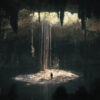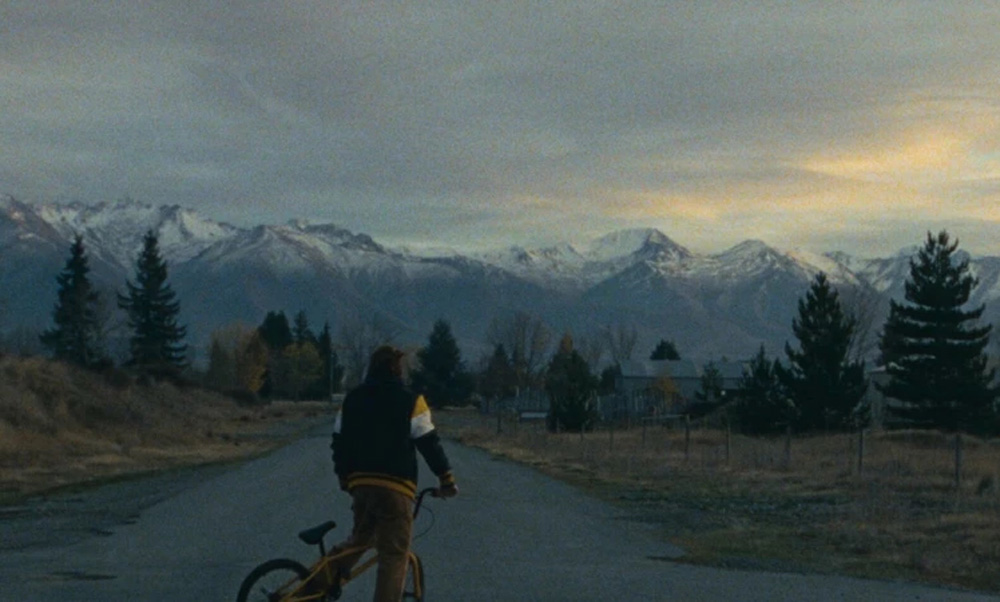It’s hard for Cyrus (Tom Kerr) to let go in “When the Geese Flew,” having an unfortunate change thrust upon him when his older sister Sammy (Lee-Ann Dirks) decides it’s time for her to move in with her boyfriend in the city after growing up in the dusty countryside of New Zealand. Already working as a mechanic at a garage where it looks like Cyrus could spend the rest of his days from high school on, one less person at the dinner table with him and his soft-spoken pa doesn’t leave much to look forward to and surely the empty table setting where his mom used to be makes him all too aware of what else he’s about to lose. Nonetheless as Sammy packs her things, he becomes intent that his sister leave whole, taking notice on his way home before she leaves of a dirt bike that was stolen from her some time ago in the possession of a local ruffian named Fraser (Jack William Parker) and becomes determined to get it back.
A confrontation with Fraser is made to appear as a broader reckoning for Cyrus, whose resistance to seeing his sister off indicative of the fear he has for facing the future as a whole and director Arthur Gay captures what becomes a defining moment in his compassionate dramatic short, premiering this week in the Directors Fortnight section of the Cannes Film Festival. Set in a place where too many are content to ride around in circles, the director and co-writer Rali Chaouni observe how the retrieval of the dirt bike becomes a revealing glimpse of how the young man at its center is holding onto way too much at such an early age. Within a tight 19 minutes, Gay watches his pockmarked protagonist grow up, recognizing life’s too short to be too stubborn about much of anything, and as the film accompanies him with cinematographer Michael Cong’s elegant camerawork and Roger Goula’s striking metallic score with the sound of gears grinding as a reminder of the industrial town he was born into and a buoyant twang to suggest the potential to get out, “When the Geese Flew” finds the beauty of Cyrus finding his wings.
On the eve of the film’s debut on the Croisette, Gay spoke about collecting his own momentum to bring the tender tale to the screen, being inspired by the film’s location and the strong collaborations that made the film what it is.
How did this come about?
I’ve been studying at Columbia University, and I just graduated last year, so this is my thesis film. [“When the Geese Flew”] came off the back of another short film that I just finished and I started writing [something that I] ultimately ended up throwing out, but it was very much the starting point of the script and I just couldn’t find the glue that was making it work. Then I moved [back to] New Zealand and this is my first project here, which has been quite a cathartic experience because the stories and characters that I seem to be writing are coming from some personal experience. Maybe not in this one so much, but often the characters I’m writing are very transient, trying to figure out what home means, which is very much part of my own experience. This one is the opposite in a way, where Cyrus is very rooted in one place, but certainly his identity is a big part of that place as well, and it felt cathartic to be back in New Zealand because it was very much an ongoing part of a narrative in my own head as I was over here, making films and trying to figure out what home is.
As an object, the dirt bike is a pretty great piece to build the story around. Was it always in mind?
It was always a dirt bike. There were early drafts of the script, which look very different to this film entirely, but there’s something raw about the dirt bike, and I like the idea of a character that conjures up when you think about someone that’s into dirt biking. They just automatically sound interesting and it also conjured up a beautiful image of him being able to cycle Sammy home on his BMX after work. But dirt bikes are just cool. Sometimes it’s as simple as that too.
It gives you license to really show off the landscape as well. Was this area one you actually knew well?
No, this was in an area in the South Island of New Zealand called Twizel, and I’ve been there a few times, but I’m from the North Island, so landscape-wise, it’s actually very different. But my ex-partner and I had walked this really long hike through New Zealand that took about four-and-a-half months and I remember walking through the Twizel area and that Southern Alps region in general and you feel yourself surrounded by the mountains. It makes you very aware of your own presence, so I really wanted to film there.
I rented a car and I just road tripped for three weeks [location scouting] through the South Island and North Island, just sleeping in a tent or in the back of the car and finally settled on the Twizel area. Very quickly, we found a lot of these spots — it’s an unlimited amount of incredible locations — and it’s also a very unique space because Twizel was built as a company town to hold these huge, hydroelectric water stations and canals and dams. And it’s quite remote, so the whole region is this town and then it’s just surrounded by these big dams and tubes, these monolithic structures that are very unique. We were very lucky to be able to film there and people were really kind to us and helped us.
That feeling of the land the sky really comes across in the camerawork and the fact you use film that has a real texture to it. Was choosing that format much of a decision?
Michael Cong, the cinematographer who I’ve worked with on numerous projects, is a very good friend of mine and he’s shot a lot on film, so that was very reassuring. But for me, there’s something about restraint and restriction and having a finite amount of material that you can use makes you intentional. That’s something that really appeals to me and somehow makes the process all the more special in a way, so that was kind of a big part of it. I’d never shot on film, and I wanted to try that. Also the quality of film feels very fitting for Cyrus’s experience there. Michael, the DP, and I were both pretty like captivated by the idea of memory, and how this could be seen as a memory and film [contributes to that] experience.
There are a few great circuitous long takes built around the bike – first when Cyrus circles around his sister at the gym and then later following him into a fight he has with Fraser. What was it like to develop how the camera would move through space?
Michael and I spent a long time starting to design our scenes and how we wanted it to feel — what’s handheld, what’s not – and there was something just really special about living. In the gymnasium scene, it was almost practical in a way at first when there was something simple about having Cyrus surrounding his sister on this bike and something elegant that felt like we didn’t want to break it up. I liked that that moment, and actually in a previous version of the script, there was a little bit more of a moment there with Sammy chases Cyrus and gets on top of him and jokingly pretends to spit in his face. Then there was something about the mirroring that scene with the fight scene that [occurs later] I was interested in and in his agency being taken, but that it’s okay with his sister because he trusts her. That moment in the scene actually ended up disappearing. But I like that there’s a mirroring between those two scenes and that fight scene was originally one full continuous take and the fight was a lot longer, but we end up cutting it. Still, I feel like there’s a conversation between that fight scene and the gymnasium scene.
What sold you on Tom Kerr to play Cyrus?
I don’t even know where to start with Tom. He’s incredible. We spent a long time casting for this and went through a lot of auditions. Eryn Wilson, our casting director, was phenomenal, and we came across Tom, who sent in a self-tape because he’s not from Auckland, and he did the scene that we were rehearsing in auditions that had the song in the background that [Cyrus] turns up and he just played this perfect song, like “500 Miles” by Peter, Paul and Mary and I [thought], “this kid already has the right sensibility,” but he was just so, so natural.” I was blown away and we instantly knew that we wanted to have him. He also turned 15 three days before we shot, but I could talk to him like an experienced adult actor. He just got it.
Then once you cast it — and it takes a bit of time, at least for me — but this person starts to embody the character and eventually you don’t see anyone else but that person anymore as the character. The Cyrus that was in my head when I was writing it felt like a different person, and when Tom Kerr fully embodied Cyrus, he came with his own nuances and his own point of view. That starts to influence the way that scenes play out, and the same goes for locating scouting because you’re trying to find an energy.
The score is also quite effective in setting a tone, with this strong industrial quality to the sound. What was it like to put music on this?
Roger Goula composed the music, he’s based out of the UK, and I worked with him on my last film and even though this is the second time I’ve had the chance to work with him, I’m like, “Oh my god, I can’t believe he is willing to work on this,” because he’s very busy and very talented. That sound specifically is a double bass with a cello bow, so it’s a very unique sound and he just got it and he’s incredible to work with.
What’s it like to get the film to Cannes now?
I don’t even know where to start, to be honest, because you’re not making films to get into festivals, but of course, you know, I’d be lying if I said I didn’t dream about being able to have a film play at any major festival, and at Directors’ Fortnight, I’d seen some films there a couple of years ago that just blew me away, so it’s a dream come true. I’m just very grateful and this is not for me, but everyone who worked on this — Laura [Ganotis, the producer] and Michael [Cong] and Rali [Chaouni, the co-writer]. and everyone in New Zealand and all my classmates and colleagues and professors. It’s everyone. But it feels very special.
“When the Geese Flew” screens at the Cannes Film Festival as part of Directors Fortnight in the Shorts Program 1 on May 21st at 2:45 pm at the Theatre Croisette and May 22nd at the Alexandre III.




